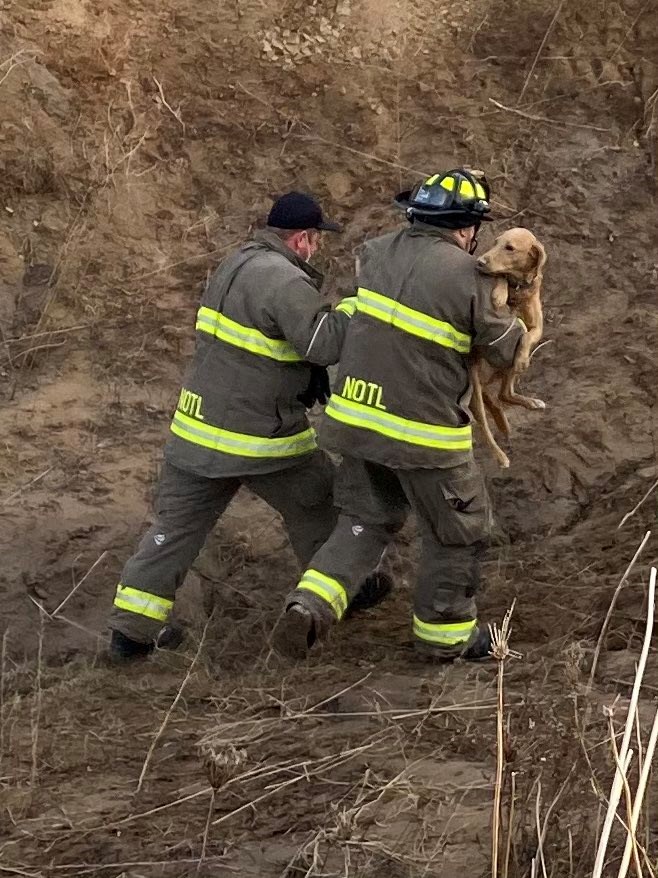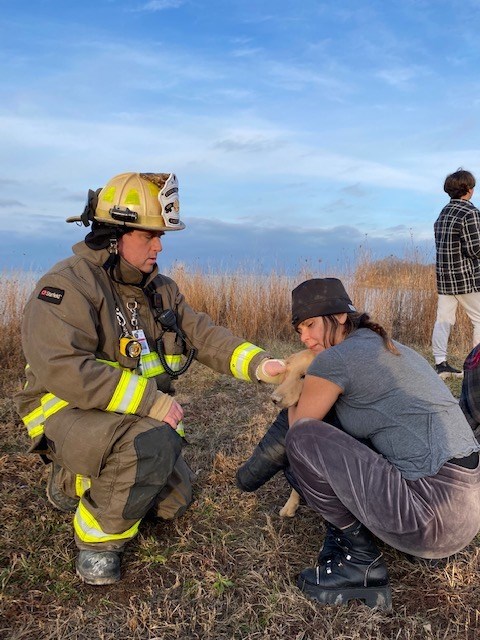A Read Road family now has their beloved pet home safely, thanks to a well-coordinated rescue by the Niagara-
on-the-Lake Fire Department, and its Virgil station volunteers.
When the call came in Sunday afternoon, says Fire Chief Nick Ruller, it was for emergency assistance. What unfolded after they met the family, who had tried to rescue their pet before calling for help, was not something firefighters have directly trained for, but have had lots of “parallels” to what has transpired during other rescues they’ve been involved it.
The golden doodle, Jazmin, was trapped in a crevice formed by shoreline erosion, says Ruller. The crevice was very narrow, only about 10 inches wide at the top, down a steep embankment near the lake, and Jazmin was lodged eight to 10 feet down inside the crevice. Her family had tried to rescue her with a pole and a loop that they were able to attach to her collar, but she was too tightly jammed in the narrow confines of the small space to pull to freedom.
Ruller says when they first arrived, with a pumper, a heavy rescue truck with specialized rescue equipment, and a pickup truck that allows access to remote locations, he used satellite imagery on their mobile data terminal to look for better access routes, and found a farm road with access from Firelane 15.
The best option seemed to be to remove the lake-side of the crevice, says Ruller.
Neighbour Joe Pillitteri arrived on his gator, after hearing the sirens on Lakeshore Road and following the trucks to the lake.
Pillitteri says his first thought when he heard fire trucks heading toward his property was that they were coming for him.
“I’d been out clearing some brush, and decided to burn it,” he says. “I had used some cereal boxes to start the fire, and when I heard the sirens, I quickly googled and discovered there is a burn ban in effect.”
The ban is to cut down on travel to help keep residents and emergency service personnel safe during COVID, he says.
“It would have been so embarrassing if they’d shown up here. I know half these people.”
When he got to the lake, he watched in awe the precision of the movements of the rescue team, as their plan was developed and put in motion.
They took their pickup truck closest to the site, loaded with equipment that included the jaws of life, a roof ladder and airbags. They used Pillitteri’s gator to anchor the ropes and tie off the roof ladder, nervous they might swing around and scare Jazmin.
Ruller says he appointed a chief rescue sector officer, whose job it was to make a plan, develop it and communicate it to the firefighters, and an incident safety officer “to look at the bigger picture, to make sure an officer didn’t put themselves in a dangerous position.” The safety officer was watching the stability of the ground, and the proximity of firefighters to the edge, he says.
As the plan was put into motion, Pillitteri watched firefighters “digging really gently from the bottom, to try to break things up, break the crevice open and free the dog. They were working almost two hours on it, and it was intense. They all did an outstanding job.”
Ruller took charge from the top, at a vantage point where he could see everyone, and calmly but sternly shouted down instructions. “It was really impressive to watch the approach they all took to solving the problem,” says Pillitteri.
“When Nick called to them to stop, they all immediately stopped, and waited while the situation was reassessed.”
Pillitteri says Ruller repeatedly called to the firefighters that safety was tantamount to the rescue, “and everyone just worked at it in a really coordinated way, in a calm, safe, methodical and easy fashion to do what they needed to do, and to make sure nobody was going to get hurt while they were doing it.”
Ruller says “it was critical that we were using measured risk, and constantly reviewing our rescue plan. My focus from up top was to ensure coordination between upper and lower activities, as they were occurring simultaneously."
It was “pretty methodical, and well-coordinated, and that limits the risk,” he says.
Pillitteri says once he felt assured the firefighters were going to be able to save the Jazmin, he decided to document what he was seeing, taking both videos and photos. “it’s really impressive, the complete calm and coordinated effort that they all gave.”
As a business owner, Pillitteri says, “I’m hyper aware of good culture, and watching them I saw a real sense of camaraderie and positive culture. That comes from good leadership, and good teamwork.”
One of Ruller’s jobs, as commander overseeing the overall operation, included keeping tabs on the elapsed time of the incident. “The reality is with an incident like this it’s very hard to gauge the time.”
During a structure fire, as an example, he says, the dispatch centre provides them with a time notification every 10 minutes, “because when you’re involved in a rapidly evolving situation, it’s hard to manage your time unless you have that clear notification.”
At one point, firefighter Jason Disher drove Pillitteri back to his shop to pick up a few extra shovels. The rescue team had enough personnel, but as they were working under the threat of the end approaching darkness, they felt they might need to move quicker, says Ruller, and extra equipment would help.
In their favour, he says, the bank was walkable, they had the jaws of life, the roof ladder to help pry the soil away, “and a lot of manual labour.”
The airbags, which are intended to help raise a car during a motor vehicle collision and can withstand great weights, were used to protect Jazmin.
They are about two feet by two feet, and just an inch thick, and when placed above the dog, protected her from soil falling on her. She was in obvious distress, and they didn’t want to contribute to her anxiety.
When he announced they were 90 minutes into the incident, he said, he made it clear “we need to be sure that this is our plan for continuing. If not, we need to look at alternatives, because we only have about 60 minutes of daylight left and that’s going to change our entire operation.” At that point they evaluated and decided they were confident of their rescue plan being effective, he says, “and it wasn’t more than 10 minutes after that discussion occurred that we successfully removed the dog.”
Pillitteri was at the top, waiting for Jazmin, along with her family.

It was “really emotional” when they carried her up the bank, and it was obvious she was going to be okay, he says. “She was really happy with Brad Disher carrying her up the hill, a little spooked obviously, but you could tell she was okay, and happy to see her owners. They were overjoyed to see their puppy.”
Ruller says the department had put in a call to the humane society once they knew what they were dealing with, in case there were any health issues, and they were also waiting. But once it was safe to say Jazmin was fine, humane society staff drove the golden doodle and her relieved family home. On Monday, her family reported to the many following the story on social media that she was fine.
He sent an email to the Virgil firefighters Sunday night, he says. Their professionalism was not lost “on myself or the deputy chiefs” during the rescue.
“Sometimes, we push hard, and it can be very demanding. The reality is this week we had several incidents where our firefighters’ performance was stellar, the direct result of the work they put in well before the incident occurs. You don’t rise to an occasion. Essentially you perform at the level of training the preparation put in prior to an incident. I’m a firm believer in the value of that training preparing you for the incident.”
It was an intense week for firefighters as they entered 2021, adds Ruller, which started with a call to attend an incident on the Niagara River Parkway on Line 3, and was reported as a fatal shooting by a Niagara Regional Police officer, now under investigation with the provincial Special Investigations Unit.
On Friday, firefighters were called out to an early morning fire in the Old Town. Three stations responded to the Windsor Circle home, which had started as a vehicle fire and spread to the house, and to one other of the four-unit row housing, successfully protecting the other two.
Ruller says his goal is always to be “over-prepared and underwhelmed” at an incident, by insuring we have well-trained firefighters.”
It’s also important that the leadership of the department advocates on their behalf to council ensuring council is equipping them “in a manner that is going to allow them to effectively do their job. We have a phenomenal combination of those things right now. We have incredible support from council, and senior management providing support from the town.”
The level of leadership is incredibly committed, as are firefighters.
“It really is a community effort, including the business owners who allow firefighters to leave their place of employment, the residents who yield to green lights so firefighters get to the incident in a timely manner, and the firefighters willing to commit that time and take time away from their careers and their families, and put that effort into it. It really is about community service at all levels.”
Ruller, whose voice softens when he speaks of Sunday’s success, admits to having a soft spot for dogs and their families.
“I’m a dog owner and a dog lover. We have an English bull dog at home, and the dog owners were there, with their kids. It’s always tough to see the that. You can empathize with their feelings. You want to do the best you can for them.”
Understanding their concern, he was glad to see Jazmin had no obvious injuries.
Pillitteri says he and his family have two small dogs they walk along the top of the embankment regularly, and Sunday was a good lesson. “This settled the argument about whether they should always be on leashes or not.”
